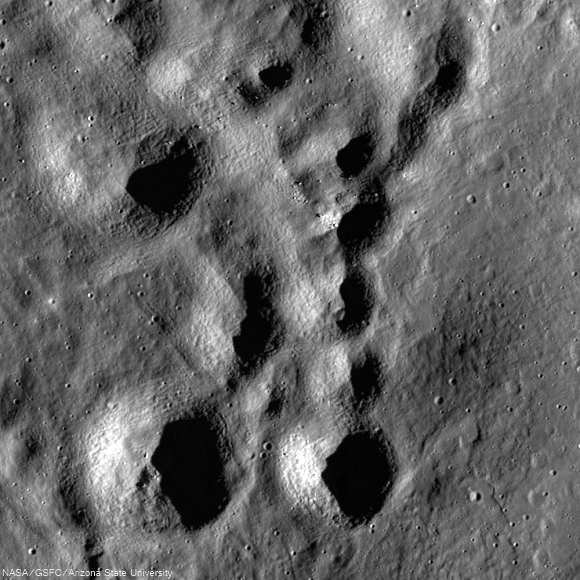 |
| Fresh ejecta patterns the landscape outside Giordano Bruno (37.99°N; 101.62°E). Illumination is from the east at a 74.28° incidence, resolution over this approximately 840 meter field of view is 1.12 meters from 54.25 km; LROC Narrow Angle Camera (NAC) frame M146308704R. LRO orbit 6695, December 6, 2010 [NASA/GSFC/Arizona State University]. |
LROC News System
The landscape surrounding the very young impact Giordano Bruno gives us a sense for how widespread the effects of even moderate-sized impacts can be on a planetary body. The young age (perhaps less than 10 million years) of Giordano Bruno offers a marvelous opportunity to inspect some of the more subtle morphologic changes that occur in the extended and discontinuous ejecta blanket during impacts of this size. Eventually, after 10's of millions of years, the action of micrometeorite impacts will rework or "garden" the lunar surface and obscure much of what we see here. Several examples of extended ejecta features are included in this post, all collected from the same Narrow Angle Camera (NAC) image (M146308704R).
 |
| Low areas like crater floors become "sinks" for migrating debris to become trapped within. Field of view is approximately 840 meter across [NASA/GSFC/Arizona State University]. |
The apparent flatness of these crater floors suggest that the debris was behaving very fluid-like when it was emplaced. Determining the difference between impact melt and granular debris flows can be challenging, however. What clues would you look for to find out if the crater floors are truly flat? How would you decide between melt and granular deposits? If impact melt, what does it suggest about the temperature of the liquid and its cooling rate to find it having such a low viscosity this far-removed from its source?
 |
| Coalescing blobs of melt have frozen together on this small crater floor (Another 840 meter FOV) [NASA/GSFC/Arizona State University]. |
 |
| A secondary crater cluster creates a hummocky Moonscape (840 meter FOV) [NASA/GSFC/Arizona State University]. |
Ejecta can create hummocky patterns when ballistically emplaced, as with these secondary craters. Some of the appearance may also be due to ground-hugging debris that piles up as it encounters resistance from friction with the ground.
How do we know that these features come from Giordano Bruno and not some other crater in the region? The full NAC image can be inspected HERE for clues. Other information on the Giordano Bruno impact itself can be found in several recent Featured Image posts, including Very Oblique View of Giordano Bruno, Sunset Over Giordano Bruno, and Giordano Bruno, The Big Picture.



No comments:
Post a Comment
Welcome, Lunatics!